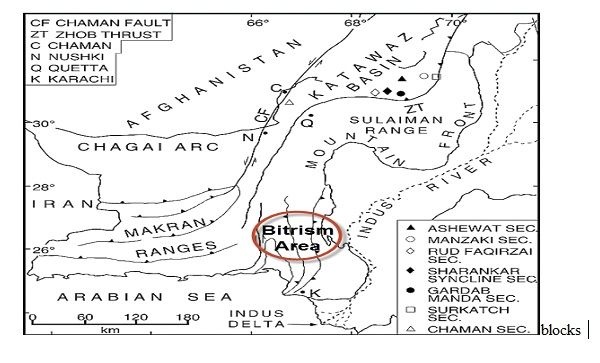Tectonics:
In the global tectonic perspective, Pakistan is situated at the junction of three lithospheric plates, the Indian Plate, Arabian Plate and Eurasian Plate. The Indus Basin is situated on the north- western corner of the Indian Plate. The Indian Plate during Jurassic-Early Cretaceous started drifting in the northeastern direction and collided with the Eurasian Plate in Paleocene-Early Eocene. The collision is characterized by continent to continent collision, obduction and thrusting and is considered the prototype Alpine-Himalayan Origen. The impact of collision combined with large scale transform movement in the west is manifested in the form of fold and thrust belts and development of sub-basins.
Major Tectonic Events:
The main tectonic events which have controlled the structures and sedimentology of the study area are rifting of the Indian Plate from Gondwanaland (Jurassic or Early Cretaceous) which probably created NE-SW to N-S rift system, iso-static uplift or ridge-push at the margins of the newly developed ocean probably caused uplift and eastwards tilting at the start of the Cretaceous.
During Lower to Middle Cretaceous the Lower Indus Basin was subjected to extensional tectonics and block faulting followed by volcanic activity, as witnessed in the southern Sindh in Pakistan and Kutch region in India. These two main episodes have greatly affected and modified the tectonics of the basin
Lower Indus Basin:
Middle and Late Cenozoic cratonic collision along the northern and western basin margins, leading to development of structurally and stratigraphically high domains.
This basin is characterized by passive-roof duplex-type structure and a passive backthrust along the Kirther Fold Belt, a passive roof thrust forming a front culmination wall along the margin of fold belt, and the Kirther depression and out-of syncline intra- molasses detachments in the Kirther depression sequence. The Kirther and Karachi depressions contain several large anticlines and domes and some of these contain small gas fields (Mazarani, Sari, Hundi, and Kothar).
Tectonic map of that area
The eastern part of basin comprising the Sindh monocline is largely comprised of faulted and tilted of Mesozoic rocks which form structural traps overlain by Deccan Trap Basalts and Tertiary sedimentary rocks .The northern margin of Lower Indus Basin comprises the Sukker Rift on which bears large anticlinal structures and contains the Khandot and Mari Gas fields. The latter is a giant field 6.3 TCF of reserves. The main reservoir rocks in the Sindh Monocline are Cretaceous Lower Goru sandstone. In the Karachi depression production is from Paleocene Ranikot limestone and sandstone, in Kirther depression and Sukker Rift zone.
Continued........
Theises work of Zahid Latif
By @samali



